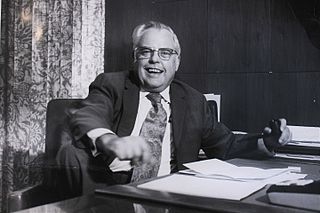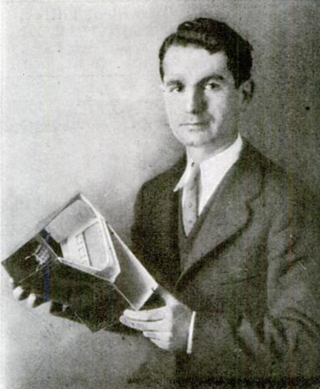
Antonio Longoria (August 14, 1890 - December 31, 1970) was a scientist who claimed to have invented a death ray in the 1930s. [1] [2] [3]

Antonio Longoria (August 14, 1890 - December 31, 1970) was a scientist who claimed to have invented a death ray in the 1930s. [1] [2] [3]
Longoria was born in Madrid, Spain, on August 14, 1890. [4] Longoria received a degree in engineering and a Ph.D. in medicine. In 1911, Longoria emigrated to the United States. Longoria moved to Cleveland, Ohio, where he married and had three children. Longoria became the president of the Sterling Electrical Company. [5] Longoria became a naturalized US citizen on December 29, 1919. [6] Longoria claimed in 1936 that patents for his process for welding ferrous and nonferrous metals by his "invisible ray" were sold for $6,000,000. [7] Longoria died on New Year's Eve, December 31, 1970, in Winter Park, Florida. [8] [9]

John Logie Baird was a Scottish inventor, electrical engineer, and innovator who demonstrated the world's first live working television system on 26 January 1926. He went on to invent the first publicly demonstrated colour television system and the first viable purely electronic colour television picture tube.

Philo Taylor Farnsworth was an American inventor and television pioneer. He made the critical contributions to electronic television that made possible all the video in the world today. He is best known for his 1927 invention of the first fully functional all-electronic image pickup device, the image dissector, as well as the first fully functional and complete all-electronic television system. Farnsworth developed a television system complete with receiver and camera—which he produced commercially through the Farnsworth Television and Radio Corporation from 1938 to 1951, in Fort Wayne, Indiana.

Sir Henry Bessemer was an English inventor, whose steel-making process would become the most important technique for making steel in the nineteenth century for almost one hundred years. He also played a significant role in establishing the town of Sheffield, nicknamed ‘Steel City’, as a major industrial centre.

Submerged arc welding (SAW) is a common arc welding process. The first SAW patent was taken out in 1935. The process requires a continuously fed consumable solid or tubular electrode. The molten weld and the arc zone are protected from atmospheric contamination by being "submerged" under a blanket of granular fusible flux consisting of lime, silica, manganese oxide, calcium fluoride, and other compounds. When molten, the flux becomes conductive, and provides a current path between the electrode and the work. This thick layer of flux completely covers the molten metal thus preventing spatter and sparks as well as suppressing the intense ultraviolet radiation and fumes that are a part of the shielded metal arc welding (SMAW) process.

Sir Hiram Stevens Maxim was an American-born British inventor best known as the creator of the first automatic machine gun, the Maxim gun. Maxim held patents on numerous mechanical devices such as hair-curling irons, a mousetrap, and steam pumps. Maxim laid claim to inventing the lightbulb.

Antonio Santi Giuseppe Meucci was an Italian inventor and an associate of Giuseppe Garibaldi, a major political figure in the history of Italy. Meucci is best known for developing a voice-communication apparatus that several sources credit as the first telephone.

William Kelly, born in Pittsburgh, Pennsylvania, was an American inventor. He is credited with being one of the inventors of modern steel production, through the process of injecting air into molten iron, which he experimented with in the early 1850s. A similar process was discovered independently by Henry Bessemer and patented in 1855. Due to a financial panic in 1857, a company that had already licensed the Bessemer process was able to purchase Kelly's patents, and licensed both under a single scheme using the Bessemer name. Kelly's role in the invention of the process is much less known.

Arc welding is a welding process that is used to join metal to metal by using electricity to create enough heat to melt metal, and the melted metals, when cool, result in a binding of the metals. It is a type of welding that uses a welding power supply to create an electric arc between a metal stick ("electrode") and the base material to melt the metals at the point of contact. Arc welding power supplies can deliver either direct (DC) or alternating (AC) current to the work, while consumable or non-consumable electrodes are used.

Harry Grindell Matthews was an English inventor who claimed to have invented a death ray in the 1920s.
Shielding gases are inert or semi-inert gases that are commonly used in several welding processes, most notably gas metal arc welding and gas tungsten arc welding. Their purpose is to protect the weld area from oxygen, and water vapour. Depending on the materials being welded, these atmospheric gases can reduce the quality of the weld or make the welding more difficult. Other arc welding processes use alternative methods of protecting the weld from the atmosphere as well – shielded metal arc welding, for example, uses an electrode covered in a flux that produces carbon dioxide when consumed, a semi-inert gas that is an acceptable shielding gas for welding steel.

William David Coolidge was an American physicist and engineer, who made major contributions to X-ray machines. He was the director of the General Electric Research Laboratory and a vice-president of the corporation. He was also famous for the development of "ductile tungsten", which is important for the incandescent light bulb.

James Hillier, was a Canadian-American scientist and inventor who designed and built, with Albert Prebus, the first successful high-resolution electron microscope in North America in 1938.

Luther George Simjian was an Armenian-American inventor and entrepreneur. A prolific and professional inventor, he held over 200 patents, mostly related to optics and electronics. His most significant inventions were a pioneering flight simulator, arguably the first ATM and improvement to the teleprompter.

Albert Garrette Burns was president of the National Inventors Congress starting in 1931 and served until at least 1939. He was known as the "Nation's Gadget Chief".

The death ray or death beam was a theoretical particle beam or electromagnetic weapon first theorized around the 1920s and 1930s. Around that time, notable inventors such as Guglielmo Marconi, Nikola Tesla, Harry Grindell Matthews, Edwin R. Scott, Erich Graichen and others claimed to have invented it independently. In 1957, the National Inventors Council was still issuing lists of needed military inventions that included a death ray.

A timeline of United States inventions (1890–1945) encompasses the innovative advancements of the United States within a historical context, dating from the Progressive Era to the end of World War II, which have been achieved by inventors who are either native-born or naturalized citizens of the United States. Copyright protection secures a person's right to the first-to-invent claim of the original invention in question, highlighted in Article I, Section 8, Clause 8 of the United States Constitution which gives the following enumerated power to the United States Congress:
To promote the Progress of Science and useful Arts, by securing for limited Times to Authors and Inventors the exclusive Right to their respective Writings and Discoveries.

John C. Lincoln was an American inventor, entrepreneur, philanthropist and in 1924, the Vice-Presidential candidate under the Commonwealth Land Party ticket. He held 55 patents on several electrical devices, founded the Lincoln Electric Co., invested in the construction of the Camelback Inn, presided over the Bagdad Mine and funded two hospitals in Phoenix, one which bears his name.

Anna M. Mangin was an American inventor, educator, and caterer. She invented a kitchen tool she called a pastry fork in 1891. This was different from the eating utensil also known as a pastry fork.
Marshall G. Jones is an American mechanical engineer, inventor, mentor, and teacher. Jones is currently a Coolidge Fellow at General Electric (GE) Global Research. He has been awarded more than 65 U.S. patents and is recognized as a pioneer for laser materials processing and a leading authority on fiber-optic laser beam technology. He is a fellow of the National Academy of Engineering and has been inducted into the National Inventors Hall of Fame.
Joseph Lee was an American baker and inventor. He successfully managed a hotel in Needham, Massachusetts for about a decade and later managed restaurants near Boston, ran a resort in Squantum, and ran a successful catering company. Lee was also an innovator, creating machines that successfully automated the process of kneading bread and making breadcrumbs. In recognition of these successes, he was inducted into the National Inventors Hall of Fame in 2019.
Albert G. Burns of Oakland, Calif, was re-elected president of the Congress. It was Mr. Burns who last year revealed that a Clevelander named Antonio Longoria had invented a death-ray which killed rabbits, dogs & cats instantly. President Burns said that Inventor Longoria would withhold his secret until invasion threatened the U. S.
He is also a persistent and well-publicized ballyhooer of the 'death ray' machine he claims to have invented. Says he, this machine can kill cats and dogs, bring down pigeons on the wing, at ranges up to four miles.
Born in Madrid 46 years ago, Antonio Longoria attended Spanish schools, got a degree in engineering and a doctorate in medicine. In 1911, he arrived in the U.S., fonder of tinkering with machines than with people. Settling in Cleveland, he married, fathered three children, became president of Sterling Electrical Co.
Patents for his newly invented process of welding ferrous and nonferrous metals by means of an invisible ray have yielded Dr. Antonio Longoria of Cleveland about $6,000,000, the inventor declared yesterday when he arrived in New York City.